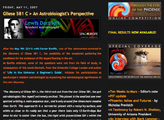Gliese 581 C > An Astrobiologist’s Perspective
 After the May 9th Q’n’A with Xavier Bonfils, one of the astronomers envolved in the discovery of Gliese 581 C, the possibility of the exoplanet gathering the conditions for the existence of life stayed floating in the air. As Bonfils referred, some of the questions were not from his field of study, in consequence of this Lewis Dartnell, from the University College London and author of ‘Life in the Universe: A Beginner’s Guide‘, initiates his participitation as spacEurope’s resident astrobiologist by explaining the astrobiological significance of this new discovery.
After the May 9th Q’n’A with Xavier Bonfils, one of the astronomers envolved in the discovery of Gliese 581 C, the possibility of the exoplanet gathering the conditions for the existence of life stayed floating in the air. As Bonfils referred, some of the questions were not from his field of study, in consequence of this Lewis Dartnell, from the University College London and author of ‘Life in the Universe: A Beginner’s Guide‘, initiates his participitation as spacEurope’s resident astrobiologist by explaining the astrobiological significance of this new discovery.
The discovery of Gliese 581 c, the third rock out from the star Gliese 581, has got astrobiologists like myself extremely excited. This planet is the smallest one ever spotted orbiting a main-sequence star, and is only around five-times more massive than Earth. This superearth is a terrestrial planet with a rocky/icy surface, and orbits so close to its ruddy sun that a year there lasts only 13 Earth-days. But since its star is cooler than the Sun, this tight orbit places Gliese 581 c within the so-called habitable zone where the warmth it receives from the star means it is not too hot and not too cold, but just right for liquid water on its surface. A second important factor affecting surface temperatures is how thick the atmosphere is and, as Xavier Bonfils says, if Gliese 581 c has an atmosphere as dense as Earth’s it may generate enough of a greenhouse warming effect to push the temperatures up to around 100degC – near the upper limit for terrestrial life.
Red dwarf stars are a particularly intriguing possibility for astrobiology, as they are far more common in the galaxy than larger sun-like stars and burn for many billions of years; perhaps making them ideal nurseries for life. There are some potentially major problems with such stars, however. These cooler, dimmer, stars necessitate a planet to orbit much closer to be warm enough for liquid water. But this means that the planet may become ‘tidally locked’ to its star, in just the same way that the Moon’s rotation has become locked to the Earth and we only ever see one side. For a red dwarf planet this would create a state of eternal day on one face of the planet, with the red sun looming motionless in the sky, and freezing never-ending night on the far side. Such a situation might create very turbulent climatic conditions on the planet, with maybe even the atmosphere frosting-out on the night side. As Bonfils explains, we do not yet know whether Gliese 581 c is tidally-locked or not, or whether a thick-enough atmosphere might be able to redistribute the heat effectively. Secondly, red dwarves can be very active stars, regularly throwing up great flares and bathing their family of planets with UV and particle radiation. Gliese 281, however, appears to be unusually calm, and so would offer life a better chance.
The most exciting prospect with future telescopes will be to filter out the brightness of the star and collect the light of the planet itself. Examining ‘absorption fingerprints’ in this spectrum will allow astronomers to read the composition of the atmosphere for any tell-tale indications of life, such as air rich with oxygen and methane.
Recommended reading:
Astrobiology journal’s recent special edition focussing on M-dwarf planet habitability and detectability of biosignatures of photosynthesis, etc:
Astrobiology, volume 7, number 1 (Spring 2007)
Read full post on Spaceurope